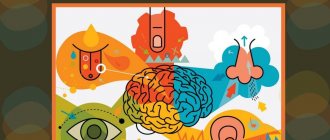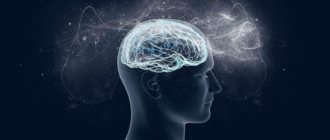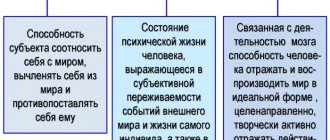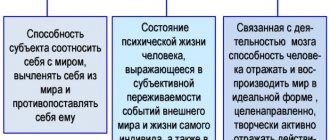Basic properties and characteristics of sensations
All sensations can be characterized in terms of their properties (Fig. 5).
Properties of sensations
Quality
Intensity
Duration
Consistent image
Spatial localization of stimuli
Each type of sensation has its own specific characteristics that distinguish it from other types. Thus, auditory sensations are characterized by pitch, timbre, volume, visual sensations are characterized by color tone, saturation, etc.
Determined by the strength of the current stimulus and the functional state of the receptor
Determined by the functional state of the sensory organ, the duration of the stimulus and its intensity
These are visual sensations that persist for some, usually short, time after the cessation of the optical stimulus. There are positive and negative sequential images. Positive is colored in the same way as an irritant, and can be very short-lived. The negative sequential image persists for a longer time and is colored in a complementary color in relation to the color of the stimulus. Knowledge of this pattern can be useful, for example, when assessing the actions of a driver who has lost control of the car at night in conditions of heavy oncoming traffic.
Spatial analysis, carried out by distant receptors, provides information about the localization of the stimulus in space. In some cases, sensations are correlated with the part of the body that is affected by the stimulus (taste sensations)
Rice. 5. General properties of sensations
All the properties described above, to one degree or another, reflect the qualitative characteristics of sensations. However, no less important are the quantitative parameters of the main characteristics of sensations - the degree (thresholds) of sensitivity (Fig. 6) [4].
Lower absolute sensitivity threshold
Upper threshold of absolute sensitivity
Difference threshold
The minimum amount of impact intensity required to produce sensations
Maximum value of pre-pain intensity of impact
The minimum difference in intensity of two similar effects necessary for its sensation
Rice. 6. Sensitivity thresholds
For any sensation to occur, the stimulus must have a certain amount of intensity.
The minimum magnitude (strength) of a stimulus capable of causing a sensation is called the lower absolute threshold of sensation, which characterizes the level of absolute sensitivity of the analyzer to the stimulus. The ability to sense these weak stimuli is called absolute sensitivity. It is always expressed in absolute numbers. For example, to create a sensation of pressure, an effect of 2 mg per 1 square meter is sufficient. mm of skin surface.
The upper absolute threshold of sensation is the maximum value of irritation, a further increase in which causes pain or disappearance of sensation. Thus, an ultra-loud sound causes pain in the ears, and an ultra-high sound (oscillation frequency above 20,000 Hz) causes the sensation to disappear (the audible sound turns into ultrasound). Pressure over 300 g/sq. mm causes pain.
The threshold of sensations changes with age. The value of the absolute threshold can be influenced by the nature of a person’s activity, his functional state, the strength and duration of irritation, etc.
Along with absolute sensitivity, relative sensitivity differs - sensitivity to changes in the intensity of exposure. Relative sensitivity is measured by the discrimination threshold (difference threshold).
The difference threshold is the minimum difference in the strength of two stimuli of the same type necessary to change the intensity of sensation. The discrimination threshold is measured by a relative value (fraction), which shows what part of the initial strength of the stimulus must be added (or subtracted) in order to obtain a barely noticeable sensation of change in the strength of these stimuli.
The lower and upper absolute thresholds of sensation (absolute sensitivity) and thresholds of discrimination (relative sensitivity) characterize the limits of human sensitivity. It should be remembered that the same stimulus for one person may be lower, and for another – higher than the threshold of sensation. The weaker the stimuli that a person is able to sense, the higher his sensitivity. In other words, the lower the absolute threshold of sensations, the higher the absolute sensitivity, and vice versa.
In people, sensitivity thresholds (lower, upper, difference) are individual and vary depending on age and a number of circumstances. A (temporary) deviation of sensitivity from the normal norm can be caused by a number of factors: time of day, mental state, fatigue, illness, etc.
During investigative experiments conducted to test the quality of sensations in witnesses and suspects, it is necessary to find out whether the subject was exposed to adverse stimuli (alcohol, narcotics or similar pharmacological substances) that increase or sharply dull the sensitivity of the analyzer.
Accepted classification
A common classification of sensations is based on their modality or specificity. The sense organs are divided into auditory, tactile, visual, gustatory, olfactory, vestibular, visceral and motor. Synesthesia is considered intermodal.
A popular classification based on the location of receptors, created by Sherrington. According to his system, sensations are divided into several types:
- interoceptive;
- proprioceptive;
- exteroceptive.
Interoceptive signals are perceived by receptors located in internal organs and soft tissues. They are able to explain the state of the body. Proprioceptive sensations are reactions that provide information about the position of the body in space and its movements. Sensory analyzers are located in muscles and ligaments.
Receptors of exteroceptive sensations are located throughout the surface of the body. They are divided into two groups: distant and contact. The first to react to stimuli that are located at a distance from the person. These include the visual, olfactory and auditory senses. The latter perceive the impact only through direct contact - touch and taste.
According to Head's genetic structure, sensitivity is divided into protopathic and epicritic. The first type is primitive; it is less localized and differentiated. Protopathic sensations are also called organic: these are hunger, thirst and everything that in any way affects a person’s life. All other senses belong to the rational and objectified epicritic type.
In psychology, modality is interpreted as a characteristic of sensations, ideas, perceptions, which indicates their belonging to specific receptors. According to this criterion, several types of feelings are divided:
- visual;
- taste;
- skin;
- organic.
With the help of vision, a person determines colors and differences in brightness. The receptor in this case is the retina of the eye, and the cortical part of the analyzer is located in the back of the head. Cones distinguish all shades of the color table; rods are necessary for orientation in the dark. Taste is perceived by the tongue: at its tip there are cells that recognize sweet food, the definition of salty and sweet depends on the root, the edges reveal acid.
Skin senses include tactile, thermal and pain sensations. Organic ones are represented by interoreceptors that determine hunger and satiety, nausea and suffocation, pain and pleasant touches.
Sensory adaptation and interaction of sensations
The change in sensitivity that occurs as a result of the adaptation of a sensory organ to the stimuli acting on it is called sensory adaptation. There are three modalities of sensory adaptation:
1. Complete disappearance of sensation during prolonged action of the stimulus. Examples of this include: adaptation to the smell of the olfactory analyzer in a person who has been working with odorous substances for a long time; auditory adaptation to constantly exposed noise, etc.
2. Dulling of sensation under the influence of a strong stimulus. For example, a temporary decrease in the sensitivity of the visual analyzer after a person moves from a dimly lit room to bright light conditions (light adaptation). This modality is called negative, as it leads to a decrease in the sensitivity of the analyzer.
Adaptation to light and darkness has a negative effect, especially in dim lighting conditions. Under these conditions, the reaction time of vehicle drivers increases, the localization of moving objects worsens, which often leads to emergency situations on the roads.
3. Increased sensitivity under the influence of a weak stimulus. For example, when a weak stimulus is applied to the auditory analyzer in conditions of complete silence (the auditory analyzer begins to detect rather weak sound stimuli - auditory adaptation).
This pattern should be taken into account in investigative (judicial) practice when assessing witness testimony. For example, it is known that complete adaptation to darkness occurs after 30–40 minutes. Sometimes an investigator may show unreasonable distrust of different testimonies of two witnesses to the same event. If one witness was fully adapted to the dark, and the other was in these conditions for only a few minutes, then the testimony of the latter will be inaccurate and incomplete. However, this should not be a reason for the investigator to show distrust of him.
All types of sensations are not isolated from each other, so their intensity depends not only on the strength of the stimulus and the level of adaptation of the receptor, but also on the stimuli currently affecting other sense organs. A change in the sensitivity of the analyzer under the influence of irritation of other senses is called the interaction of sensations (Fig. 7).
Interaction of sensations
Interaction between sensations of the same type. Thus, gray on a white background will look darker, and surrounded by black it will look lighter.
Interaction between sensations of different types. Thus, sound stimulation can sharpen the work of the visual analyzer, increasing its sensitivity to light stimuli
Increased sensitivity as a result of interaction between analyzers or exercise (sensitization)
The appearance, under the influence of irritation of one analyzer, of a sensation characteristic of other analyzers (synesthesia)
Rice. 7. Interaction of sensations
Sensitization (from Latin sensibilis - sensitive) is an increase in the sensitivity of analyzers under the influence of internal (mental) factors. Sensitization or exacerbation of sensitivity may be caused by:
- interaction of sensations (for example, weak taste sensations increase visual sensitivity). This is explained by the interconnection of analyzers, their systematic work;
- physiological factors (the state of the body, the introduction of certain substances into the body; for example, vitamin A is essential to increase visual sensitivity);
- the expectation of a particular influence, its significance, a special attitude towards distinguishing certain stimuli;
- exercise, experience (thus, tasters, by specially exercising their taste and olfactory sensitivity, distinguish between different types of wines and teas and can even determine when and where the product was made).
This mechanism of interaction of sensations can influence the quality of the investigative experiment, the completeness and objectivity of testimony. For example, it is known that visual sensitivity is significantly reduced when the olfactory receptor is exposed to an unpleasant odor. This circumstance must be taken into account when examining the scene of the incident, a corpse with significant cadaveric changes, and during exhumation. In such cases, in order to complete the entire volume of work at the proper level, the investigative team needs to take breaks from work.
In people deprived of any type of sensitivity, this deficiency is compensated (compensated) by increasing the sensitivity of other organs (for example, increasing auditory and olfactory sensitivity in the blind). This is the so-called compensatory sensitization.
Synesthesia (from the gr. synaisthesis - joint sensation) is an associative non-modal sensation that accompanies the real one. For example, some people, under the influence of sound stimuli, may experience vivid visual images, different taste sensations, etc.
When sensations interact, a phenomenon called contrast of sensations can occur. This occurs in cases where the same stimulus is perceived by the analyzer depending on the qualitative characteristics of another stimulus that acted on the same analyzer simultaneously or sequentially (for example, a sequential contrast of taste sensations). Contrasting phenomena often lead to errors in sensations, which, in turn, lead to errors in testimony. For example, witnesses to one crime stated that the perpetrator was wearing a white suit and was very tall; in reality, they saw a man of average height, wearing a gray suit against a black background. Knowledge of the patterns of sensations contributes to more qualified detection of crimes.
In the work of a lawyer, sensations form the basis of a more complex process of perceiving objects and phenomena; they are directly related to the performance of professional activities and have a significant impact on it.
Definition
Sensation is considered the process of perceiving the surrounding world through human senses. This definition was given by Goethe, who believed that the integrity of the image can only be formed through the work of several organs - they allow the individual to naturally build a reaction chain in order to then process non-verbal information.
Perception, as R. L. Gregory of the school of neurolinguistics believed, is the overall picture of what a person has already experienced. If, for example, he drank coffee, then it would be natural to consider his perception to be the signal that he would have received after the same action under equally repeated conditions.
If a person drinks coffee while sitting in the rain, in the wind, then perception will be impaired. The pattern, in this case, of this sensation will be changed due to the presence of secondary factors. The same thing happens with sensation - under ideal conditions, a person enjoys the drink.
With additional criteria, he can change the interpretation of his perception, and the sensations will be different.
The behaviorist school, like J. Muller, believes that people measure absolute thresholds using a method called signal detection. This process involves presenting stimuli of varying exploration intensities. The German physiologist Ernst Weber (1795–1878) made an important discovery in his school of psychology when he declared the existence of an absolute threshold.
The ability to detect differences depends not so much on the size of the difference, but on the size of that same difference in relation to the absolute size of the stimulus. Weber's law states that the only noticeable stimulus difference is a constant proportion of the original stimulus intensity.
As an example, the simplest “truths” are given: if a person drinks a cup of tea with 1 spoon of sugar, and then adds a second one, the difference will be colossal. A person will enjoy the tea after adding the second spoon. If there are 4 servings of sugar in it, then adding a 5th will not change anything. To get new sensations, you need to follow the “doubling” pattern, adding another 4-5 spoons.
Marx spoke about a similar phenomenon when he mentioned that it is enough for a person to feel a good attitude towards himself. At the same time, working conditions may change, but it is important for a person to receive recognition, not criticism. Despite rising pay as attitudes towards the working class change, many will choose “healthy psychological” relationships at work over high pay.
This is also associated with a feeling of fullness - it is enough to get a glass of water, satisfying your thirst, than to drink 5 bottles without getting the same sensations with each new one. The pattern in this case comes down to the interpretation of reverse saturation.
Touch
The process of combining skin and motor sensations is called touch. To touch, a person owes his ability to evaluate such properties of objects as hardness, softness, smoothness, roughness. The hardness or softness of an object cannot be determined without the participation of motion sensations. The feeling of hardness depends on how much resistance the body offers when pressure is applied to it, and this is related to the degree of muscle tension. All types of sensations are interconnected, thanks to which a person receives information about the world around him. But this information is limited to information about the properties of objects, a holistic image that a person receives through perception.
Get paid for your student work
Coursework, abstracts or other works
Management methods
To study the pattern, formulas and methods for assessing the results were given. And methods have been developed to control these features of natural phenomena. They are based on the fact that a person has additional receptors that can also sense certain stimuli.
To manage them, you need to consider the following:
- Physiological pain - nociception indicates damage to nerve endings. Results different from the norm indicate that the pattern of the reaction is disrupted.
- Balance of perception: If a person senses movement, direction and acceleration/deceleration, then he can maintain the balance of the body. Otherwise, the pattern of perception is broken and requires additional influence (correction/treatment).
- Body awareness - proprioception is provided by the parietal cortex.
- The sense of time - chronoception is observed during the measurement of the sensory perception system. The pattern may be disrupted due to the regulation of the time perception system.
- Sensing or thermoreception - the sensation of heat or cold is observed with the natural sensation of temperature phenomena.
Also, methods for assessing patterns include interoceptive sensations, including the sensations of muscle stretching, lack of oxygen and other perceptions. The patterns of sensations in psychology can be studied using the methods of I. Zenverg, which include chemical detection, detection of light, force and temperature.
Chemoreception
J. Rotter founded a method for diagnosing chemical receptors. If they work correctly, the pattern of sensations will increase with the proportional increase in chemical stimuli.
For testing, you can conduct a regular study:
- apply a sweet or saline solution;
- increase intensity by 2-3 points;
- reduce intensity by 2 times;
- compare reflexes and human reactions.
This testing can be done at home.
Photo reception
To diagnose the pattern of perceptual sensations, it is necessary to create conditions for research:
- A person can control the body and feel it in a state of rest.
- The individual must not be aware that testing is taking place.
- In order for the method to show true results, it is important to study the characteristics of the body in advance.
Photoreception allows you to assess how natural a person’s sensations are in given conditions when they change relative to time.
Mechanoreception
The sense of chronoreception is controlled by the suprachiasmatic nucleus.
If the pattern of mechanoreception is violated, it is necessary to conduct testing:
- place the person in isolation;
- develop a “morning-afternoon-night” concept;
- influence through biori src=”https://healthperfect.ru/wp-content/uploads/2020/03/zakonomernosti-oschuscheniy-v-psihologii-7.jpg” class=”aligncenter” width=”700″ height=”429 ″[/img]
When conducting research, it is important to record all manifestations to identify a natural response over time. Otherwise, the test will be considered failed. To manage such a condition, you need to choose the right interpretation method. It is best to go to a teaching hospital to get tested. Its price will be 2000-2500 rubles.
Thermoreception
Temperature sensitivity can be measured at the molecular level to guide the methodology for measuring regular reactions and how they occur.
The transient or hyperventilation control method makes it possible to identify developmental defects in children in neonatology. In adulthood, a person is subjected to tests, which are carried out in a clinical hospital and a psychiatric clinic.
A pattern in psychology means identifying a specific connection between sensations and phenomena occurring in the body and brain of an individual. The higher the strength of sensations, the more intense the patterns of manifestation. And, conversely, the more intensity is needed, the lower the threshold of sensitivity a person feels.











